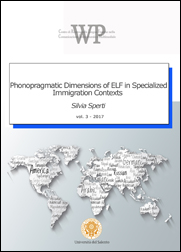
ISSN: 2499-1449
ISBN: 978-88-8305-123-4
DOI: 10.1285/i24991449n3
This study focuses on the application of the ‘phonopragmatic’ approach to the analysis of institutional legal interactions through English as a Lingua Franca (ELF) in intercultural immigration domains characterized by ‘gatekeeping’ asymmetries between the participants, where achieving successful communication through mutual accommodation strategies appears challenging, if not sometimes controversial. The research hypothesis is that ELF users involved in intercultural encounters differently appropriate the English language not only according to their own different native linguacultural ‘schemata’, but also to specific pragmalinguistic goals and processes. The phonopragmatic approach, therefore, aims to explore the possible prosodic and auditory processes involved in such cross-cultural dynamics, with reference to speakers’ illocutionary and pragmatic intentions and the performing of speech acts. The approach is applied to five case-studies selected from a corpus of recorded cross-cultural interactions between asylum-seekers, refugees, language mediators and legal advisors, taking place at a centre for legal counselling and assistance, involving ELF and Italian as a Lingua Franca.
The PRAAT software is here used with the purpose of investigating the use of prosodic strategies by ELF speakers from different L1 backgrounds, with the ultimate aim of investigating and describing: (i) how existing L1 prosodic and acoustic variations (in terms of e.g. stress, intonation, speech rate, and disfluency) are redefined in the use of an ELF variation; (ii) to what extent the resulting L1 phonological transfers affect ELF variations (in terms of phonological phrasing, syntactic and lexical choices); (iii) how meaning and experience are mediated and cross-culturally constructed in interactions through phonopragmatic strategies; and (iv) the role played by prosody and paralinguistics in the negotiation of speakers’ attitudes, emotions, and socio-cultural ‘schemata’.
Table of Contents
| Frontespizio e pagine iniziali |
PDF
|
|
Silvia Sperti |
1-2 |
| Table of Contents |
PDF
|
|
Silvia Sperti |
3-4 |
| Introduction: a phonopragmatic approach to the analysis of ELF cross-cultural communication |
PDF
|
|
Silvia Sperti |
5-7 |
| Theoretical Background: Focus on ELF Variations |
PDF
|
|
Silvia Sperti |
7-29 |
| Theoretical Background: Focus on ELF Phonology |
PDF
|
|
Silvia Sperti |
29-64 |
| The Phonopragmatic Model and the Research Method |
PDF
|
|
Silvia Sperti |
64-85 |
| Phonopragmatic Analysis |
PDF
|
|
Silvia Sperti |
86-160 |
| Conclusions |
PDF
|
|
Silvia Sperti |
160-180 |
| Colophon |
PDF
|
|
Silvia Sperti |
181-182 |
Questo sito utilizza un cookie tecnico per consentire la corretta navigazione. Se vuoi saperne di più consulta l'
informativa estesa.
e-ISSN: 2499-1449
 ISSN: 2499-1449
ISSN: 2499-1449
